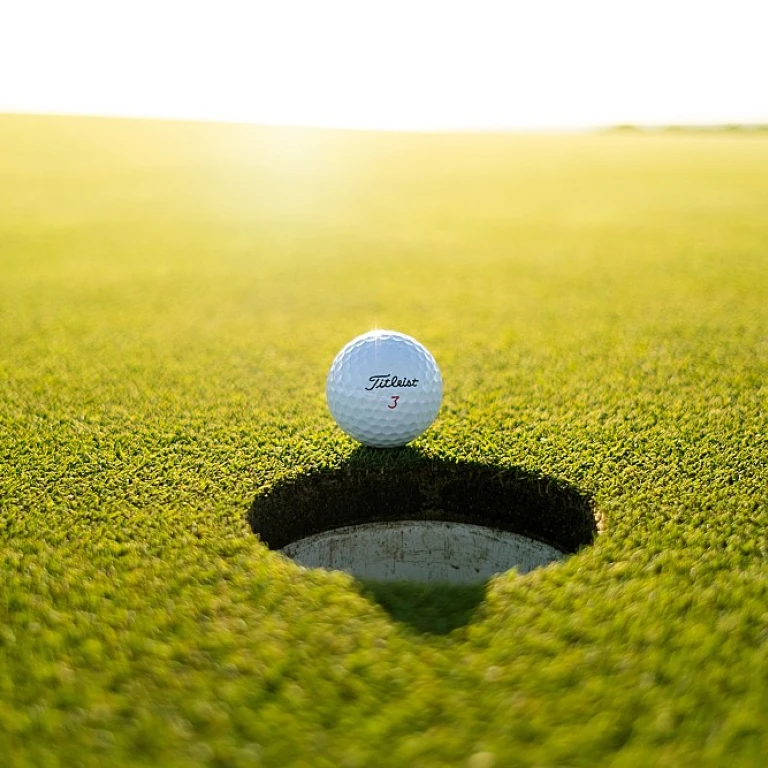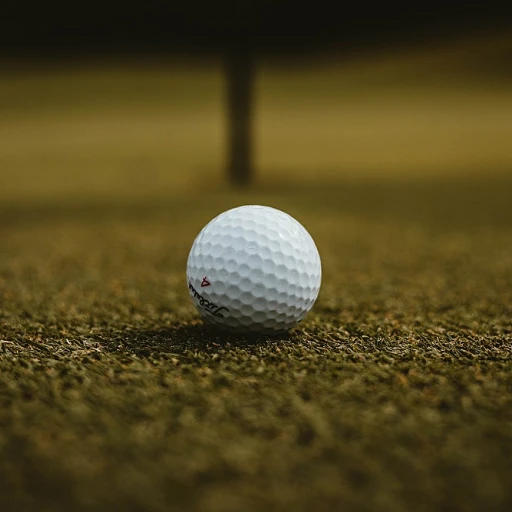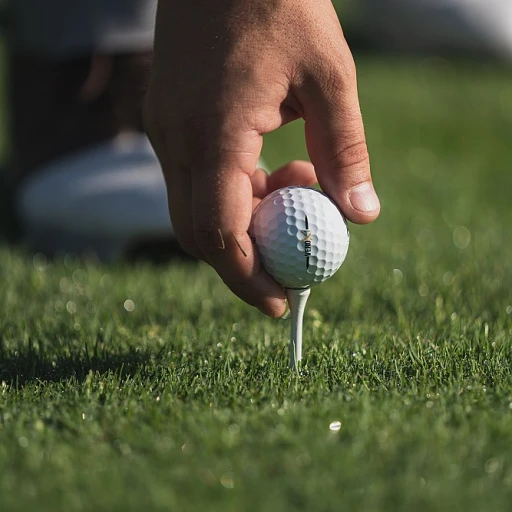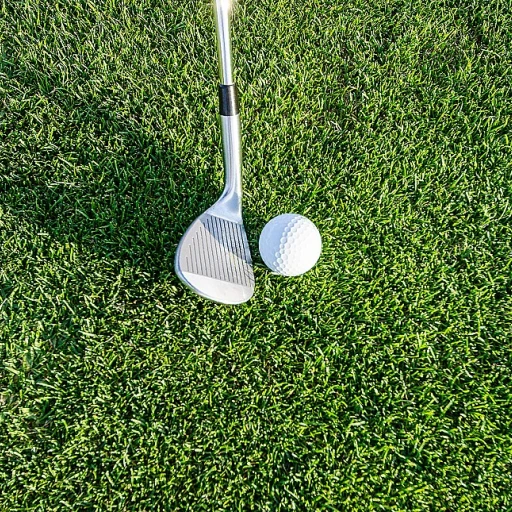
Understanding the fundamentals of a golf swing
Grasping the basics of your golf swing
The game of golf starts with mastering the golf swing, and let’s face it, if you don't get the fundamentals right, you might as well throw your golf club in the nearest lake. Many amateur golfers find themselves struggling because they don't have a solid foundation to build on. Let's break down the essentials so you're not left guessing next time you hit the course.
First off, let’s talk posture. Everyone from amateur golfers to pros like Nick Faldo emphasize the need to maintain a good golf stance. Your feet should be shoulder-width apart, knees slightly bent, and your back straight. This might sound like a minor detail, but trust me, it's the bedrock of a good golf swing.
Next up is alignment. Never underestimate the importance of lining your body up properly with your target. Your shoulders, hips, and feet should all point towards a specific target. Ben Hogan often spoke about the 'imaginary target line' - an invisible line from behind the ball through the target. Trust this imaginary line as if it's your best friend.
The last puzzle piece for the basics is understanding the swing path. Research shows that approximately 85% of the direction your golf ball takes is determined by your club face angle at impact (source: TrackMan). Visualize your club face meeting the ball squarely at impact for straight golf shots. Your swing path should be an arc, not a straight line - keeping this in mind will help you control the ball better.
So there you have it. Sort out your posture, alignment, and swing path, and you're already miles ahead. But this is just a warm-up. In our next section, we’ll delve into the importance of your golf grip, a critical element that often gets overlooked but can transform your golf game.
For those looking to refine their iron game, don't miss the ultimate guide to mastering the 9-iron - it’s a must-read!
The importance of grip in your golf swing
Why your grip can make or break your golf game
Your grip is the foundation of your golf swing. Imagine trying to write with a pen held awkwardly, that's your golf swing with a poor grip. When we talk about golf, it's easy to get focused on the club, but the magic often starts with your hands. Nick Faldo, a legend in golf, stressed the importance of a good grip, mentioning it as one of the primary tips for a consistent golf swing.
A solid grip establishes control over the club face, which is vital in making solid contact with the ball. For instance, a weak grip can lead to an open clubface at impact, causing you to hit a slice. On the other hand, a strong grip can close the clubface too much and lead to a hook.
According to a study published in the Journal of Applied Biomechanics, the hand position and grip strength significantly influence the clubhead speed and shot accuracy. Ensuring your left hand (if you're right-handed) sits comfortably on the club and your right hand follows, can make a world of difference in your game.
The various types of golf grips and choosing the best for you
There are three primary types of grips: the overlapping (Vardon) grip, the interlocking grip, and the ten-finger (baseball) grip. Each has its nuances and it’s all about finding what suits your style.
- Overlapping grip: Used by golfers like Ben Hogan, it's ideal for those with larger hands.
- Interlocking grip: Popular with players like Tiger Woods, it’s great for people with smaller hands and provides more control.
- Baseball grip: Common amongst beginners and those struggling with the other grips, it can generate more power but less control.
Trying out these grips at your local driving range and practicing will help in determining the best fit for improving your golf swing. Remember, the right grip doesn’t just influence your swing, it impacts your comfort and endurance on the golf course.
Expert advice and common mistakes
In conversations with seasoned golfers and coaches, some common advice crops up—a consistent and light grip pressure. As pointed out by Butch Harmon, one of the top golf instructors, “applying too much pressure can create tension throughout the swing, costing both distance and accuracy.”
Here are a few common mistakes to watch out for:
- Gripping the club too tightly, resulting in tension and lack of feel.
- Inconsistent grip pressure, which can lead to erratic shots.
- Incorrect placement of hands, causing either slices or hooks.
Incorporate the right grip regularly in your pre-shot routine to create a habit. Over time, a well-practiced grip will feel second nature, helping your game immensely by keeping shots straight and true.
Mastering the backswing and downswing
Setting up for success: right positioning and posture
Having a solid grip is just one part of swinging your way to victory on the golf course. Another essential element lies in perfecting your stance and posture. Here, we'll break it down step-by-step. Get comfortable with your stance. Your feet should be about shoulder-width apart. Flex your knees slightly to keep balanced. Ben Hogan, a golfing legend, emphasized in his book "Five Lessons" the importance of addressing the ball consistently with a simple and repeatable stance. Your weight balance matters. About 60% to 70% of your weight should be on the balls of your feet. This helps maintain stability throughout your swing and reduces the chance of swaying. Nick Faldo, a six-time major champion, stresses the importance of a strong base. Align the shoulders. Check a full-length mirror if needed: your shoulders, hips, and feet should be parallel to your target line. Proper alignment directly impacts your swing path and the accuracy of your shots.The perfect grip for precision
Let’s get into the nitty-gritty of gripping your golf club. There are various grip styles, but some of the most effective are the overlapping (Vardon), interlocking, and ten-finger (baseball) grips. These grips are commonly recommended by golf instructors. Find your ideal grip pressure. Experts suggest a “4 out of 10” pressure rating while gripping your club. Too tight, and you'll lose fluidity; too loose, and you could lose control. Think of it as holding a tube of toothpaste – enough to keep hold of it, but not so much that you squeeze anything out. Proper hand placement means placing your left hand first (for right-handers) and having the grip run from the base of your fingers to just above their joint. Your right hand should sit comfortably below, with the pads of your fingers cradling the grip. This ensures the best golf swing through maximum control and power.The golden rule of backswing
The backswing sets the stage for a powerful and controlled hit. To master it, start slow and maintain a straight left arm. Many pros like Tiger Woods focus on a controlled and smooth takeaway. Your club, arms, and shoulders should move in unison. As you reach the top of the backswing, maintain a 90-degree angle between your left arm and the shaft of your golf club. This creates a torque that powers your downswing, as explained in various tutorials and lessons, such as those taught by reputable golf instructors like David Leadbetter.The precision of the downswing
Transitioning from the backswing to the downswing needs to be seamless. Shift your weight to your left foot (for right-handers) and rotate your hips toward the target. This movement acts like a whip, propelling your clubhead with maximum speed at the point of impact. A common mistake among amateur golfers is an early release. Keep your wrists hinged until your hands are in front of your body, then let the club release. Jack Nicklaus often mentioned that this delayed release is a key to longer and straighter shots. Remember, practice these steps and keep refining your grip, stance, backswing, and downswing at your local driving range. For more on how understanding your swing fundamentals can enhance your game, check out our swing like a pro guide. For more detailed tips and improving your golf game, ensure to follow through the entire series.Achieving the perfect impact and follow-through
The anatomy of a perfect impact
A great golf swing isn’t just about how far you can hit the ball; it’s about precision and control at the moment of impact. When you reach the bottom of your swing, where your clubface meets the ball, you want everything to align perfectly for the best shot possible. Let's dive into the nitty-gritty of nailing that perfect impact spot.
First things first, aligning your clubface correctly is essential. Studies have shown that the position of the clubface at impact dictates the direction of the shot up to 85%. This means if your clubface is even slightly open or closed, it can cause the ball to veer off course significantly.
Engage your lower body
Your lower body plays a crucial role in achieving the perfect impact. Engaging your hips and legs not only provides power but also helps in maintaining balance. Golf legend Ben Hogan emphasized the importance of using your lower body to generate torque and create a solid foundation during the swing. According to Hogan, the transition from backswing to downswing should begin with a smooth rotation of the hips, not an aggressive action, ensuring a powerful yet controlled impact.
Focus on the clubface
Maintaining a square clubface is fundamental. Experts like Nick Faldo often stress the importance of hitting the ball with a square clubface. This reduces side spin and promotes a straighter, more accurate shot. According to TrackMan data, even a one-degree deviation from square can result in the ball missing the target by yards.
Perfecting follow-through
Don't underestimate the follow-through. A fluid, complete follow-through is as important as the backswing and downswing. It ensures that your body and swing are in sync till the end. Over 60% of amateur golfers tend to cut their follow-through short, which can lead to inconsistencies and loss of power. Keep your arms and body extended through the swing, your club should point towards your target as you finish.
Use impact tape
If you’re struggling with finding the perfect impact zone, using golf impact tape can be a game-changer. This simple tool provides instant feedback by showing where your clubface strikes the ball. Aim for the center of the club face, ideally within a range of a few millimeters.
The next time you head to the driving range for practice, remember: it's the little adjustments at the impact point that can make a world of difference. For an in-depth look at how to master your iron shots, don’t forget to check out how to swing a driver mastering the art of the perfect golf swing on our blog.
Improving ball striking and accuracy
Enhancing accuracy with every shot
When it comes to perfecting your ball striking and boosting accuracy, you want to zero in on a few key principles that make all the difference. And let's be real, it's not just about brute strength; it's about finesse and precision. According to Ben Hogan, one of the absolute legends in golf, 'The secret is in the dirt,' implying that consistent practice is key. It all begins with a solid foundation and disciplined routine.
Leveraging the power of mechanics
One critical component is understanding the mechanics of your swing. Your stance plays a huge role here. Many amateur golfers find that aligning their body properly can vastly improve their swing. When Nick Faldo, a six-time major champion, refereed to his golf stance in his prime, he focused on positioning to maintain balance and ensure a smooth swing.
Getting a grip on control
Your grip on the golf club is another critical area. Holding the club too tightly can rob you of control and lead to inconsistent shots. During practice, focus on keeping your grip firm but relaxed. This will help develop a natural swing rhythm that is paramount for precise ball contact.
Practice with a purpose
Targeted practice at the driving range can significantly improve your accuracy. Each practice session should have a specific goal, whether it’s enhancing your iron shots, mastering the golf club face alignment, or engaging the lower body more efficiently in your swing. The driving range is your laboratory for testing these tweaks and refining your approach.
Repetition and mental focus
Finally, it's about repetition and keeping your mental focus sharp. Incorporate a pre-shot routine that helps you align your focus before each swing. According to a study published in the International Journal of Golf Science, mental routines can significantly impact shot accuracy and consistency by up to 20%. This underscores the importance of not just physical practice but mental preparation as well.
Working on these elements consistently will help improve golf swing effectiveness, driving you to better ball striking and overall more accurate shots. Whether it’s your iron shots, putting, or tee-offs, putting these tips into practice is sure to elevate your game to new heights.
Using the driving range for practice
Making the most of your driving range sessions
Are you maximizing your driving range time? It’s not just about hitting some random shots; it’s about purpose-driven practice. One of the best golf tips to improve your game is having a plan before you even step onto the turf.Targeted practice
Have a specific target in mind before each shot. Professional golfers like Nick Faldo and Ben Hogan didn’t become legends by swinging aimlessly. They visualized every stroke, deciding precisely where they wanted the ball to land. By setting a clear target, you refine your swing and train your body to form consistent, repeatable motions.Varied club selection
Don’t get stuck using just one club. Rotate through your golf clubs to simulate different situations on the golf course. Practice with your irons, hybrids, and woods. This practice will help you become an all-rounder, improving your shots across the board.Focus on consistency
Watch your body’s mechanics. Use driving range practices to perfect your backswing, downswing, and follow-through. Consistency is key to good golf. Observing your swing in a mirror or recording it on video can be beneficial. Regularly analyze and adjust your technique to see the best golf swing results.Practice mindfully
Practicing with intention will help you improve faster. Keep track of your progress and note down any patterns. Consistency in practice sessions will have a tremendous impact on your overall performance on the course. Remember, it’s not just about the quantity of shots but the quality. Stay committed to these golf swing tips and routinely implement them in your practice. Your time spent on the driving range will help you develop a better golf swing, hit straighter shots, and ultimately become a more confident and capable golfer.The role of mental focus and pre-shot routine
Fostering mental resilience on the fairway
Before you even pick up your golf club, it's crucial to understand how much your mind plays a role in your swing. Mental focus isn't just a fancy idea; it's often the difference between hitting a straight shot and slicing the golf ball into another fairway. Ben Hogan himself once said, "The most important shot in golf is the next one." Coming to terms with bad shots and moving on without frustration can help keep your game steady and your mental composure intact.Establishing a structured pre-shot routine
Having a consistent pre-shot routine is a fundamental tip to help maintain mental focus. Many amateur golfers find that a repeatable routine helps block out distractions and get into the right mindset. Nick Faldo, renowned for his analytical approach, has often highlighted the importance of a solid pre-shot plan. Begin by visualizing your target and running through your checklist—your stance, grip, and swing path.Visualization techniques and their impact
Visualization isn't just for elite golfers; it's a powerful tool for anyone looking to improve their game. Spend a few moments before each shot picturing the perfect impact and follow-through in your mind. Studies reveal that mental visualization can lead to better actual performance. Imagining a straight golf shot hitting a specific target can mentally condition you to replicate it when you pick up your club.Dealing with pressure and staying in the zone
Pressure is inevitable, especially when you're striving to save par or hit that clutch birdie. A key tip is to focus on your breathing. Controlled, deep breaths can help lower your heart rate and clear your mind. Statistics show that maintaining composure under pressure can positively influence your success rate on pressure shots.Combating negative thoughts during the game
Negative thoughts can unravel even the best golf swings. Cognitive Behavioral Techniques (CBT) can be beneficial here; challenge those negative thoughts and replace them with positive affirmations. Instead of thinking, “I’ll never hit this shot good,” tell yourself, “I’m capable, and I’ve practiced this shot countless times.” Studies indicate that a positive mindset can improve performance by up to 5%. By incorporating these mental strategies, you’ll not only be able to maintain a good golf swing but also improve your overall game. Practice these tips consistently, and you'll notice a substantial difference in how you handle the psychological aspects of golf.Analyzing and adjusting your swing
Understanding your swing path
Your swing path is one of the most crucial elements in analyzing and adjusting your golf swing. According to a study by Golf Digest, 75% of golfers tend to have a natural swing path that either draws or fades. Understanding whether your swing path is inside-out or outside-in can help you make necessary adjustments to improve your game.
Using technology to track performance
Technology has revolutionized how golfers evaluate their swings. Tools like TrackMan and GCQuad provide precise data about ball speed, launch angle, and club path. PGA pro Nick Faldo states, “These technologies offer invaluable insights that even seasoned golfers often overlook.” Using such devices during your driving range practice can highlight areas for improvement you wouldn't catch with the naked eye.
Consulting with experts
Sometimes, a pair of professional eyes can see what you can't. Having a session with a certified golf coach can provide actionable tips to refine your swing. Ben Hogan, a legend in the golf world, often emphasized the importance of expert consultation for continuous improvement. A study by the American Golf Teachers Federation revealed that golfers who regularly consult with professionals improve 40% faster than those who don’t.
Recording and reviewing your swing
Recording your swing and reviewing it can help you identify issues such as improper grip, misaligned stance, or inefficient follow-through. Make use of smartphone apps or video cameras to capture your swing from various angles. Reviewing this footage can help you understand what needs to change for an improved golf swing.
Participation in golf training programs
Enrolling in specialized golf training programs can significantly enhance your understanding and execution of the game. Programs often offer a structured approach with focus areas like swing mechanics, mental game, and course management. Golfers who participate in such training see over a 30% improvement in their swing efficiency, according to a report by Golf Academy.
Reading your body for signs
Your body can give you critical feedback about your golf swing. Shoulder and back pain might indicate improper posture or swing mechanics. Consulting with physical therapists who specialize in sports can provide you with exercises and stretches to address these issues. “Recognizing the physical signs your body gives you is as important as understanding any club or ball data,” says sports psychologist Dr. Mark Smith.
Implementing gradual changes
Adjusting your golf swing is not an overnight process. It requires incremental changes and consistent practice. Experts suggest focusing on one aspect at a time, like grip or stance, before moving on to other elements. This systematic approach ensures long-term improvement and better muscle memory retention.













